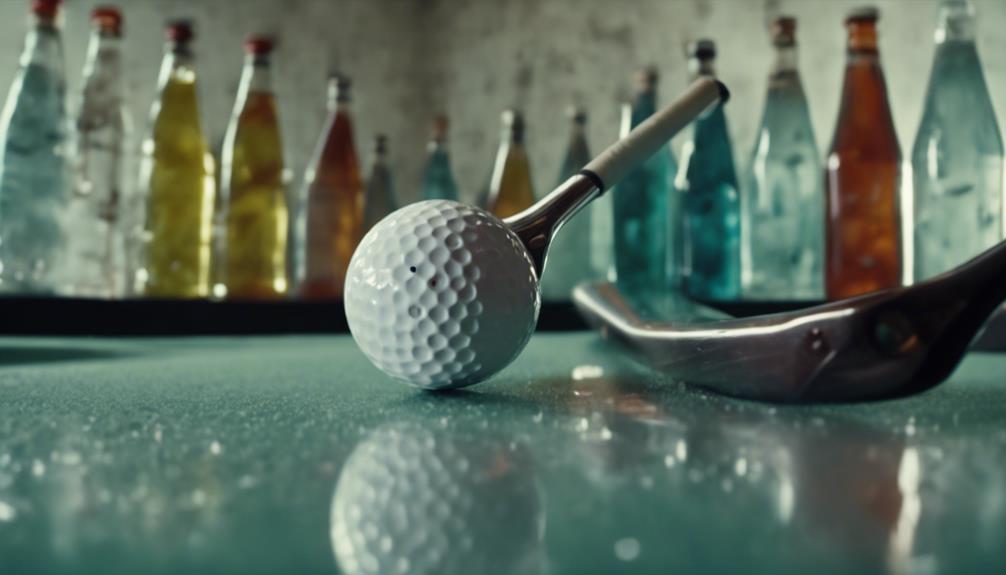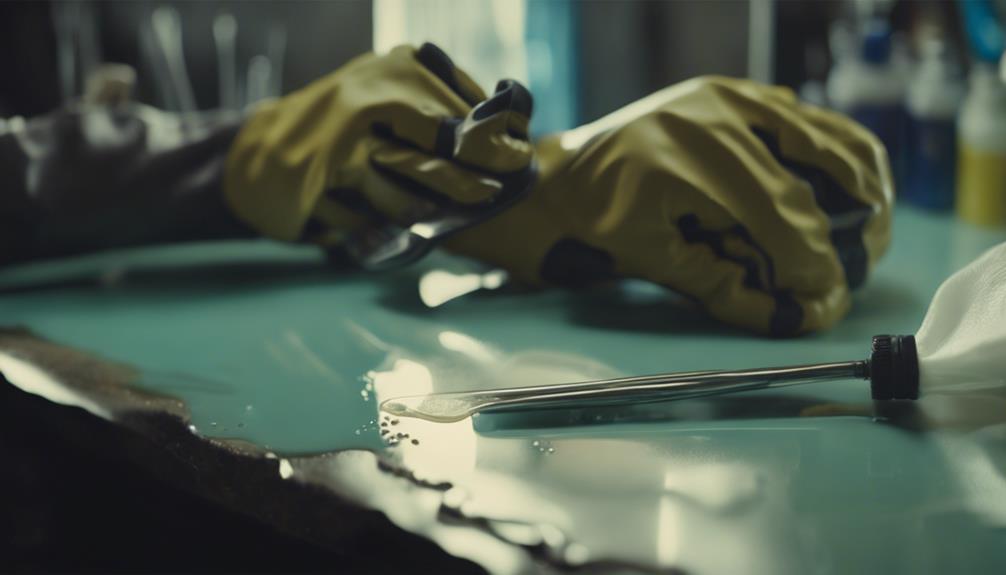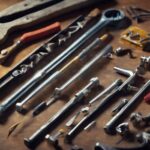- 7 Top Flite Golf Clubs XL for Improved Performance - September 28, 2024
- Top Flite Golf Clubs: Top 5 Reasons to Choose Them - September 28, 2024
- Top 3 Golf Club Fitters for a Perfect Swing - September 28, 2024
You need a high-strength epoxy resin that can withstand the unique forces and extreme temperatures generated by a golf swing. Evaluating epoxy options requires considering the Tg (glass conversion temperature) to verify it can handle the demands of the game. Selecting the right epoxy is crucial for golf club repair, as it directly impacts performance, durability, and lifespan. Popular choices include 3M DP460, GolfWorks Tour Set epoxy, and 3M 8410NS, each offering high lap shear strength and suitable mix ratios. As you explore the world of epoxy resins for golf clubs, you'll uncover the nuances that set top performers apart.
Key Takeaways
- High-strength epoxy resins like 3M DP460 and 3M 8410NS are popular choices for golf club shafting due to their high lap shear strength.
- Selecting the right epoxy is vital for golf club repair, as it directly impacts the club's performance, durability, and overall lifespan.
- Epoxy adhesives with high lap shear strength and temperature resistance, such as 3M DP460, are recommended for golf club shafting to withstand the unique forces of a golf swing.
- Customizing golf clubs with epoxy allows for precise control over the shaft's alignment, flex, and torque, enabling golfers to tailor their clubs to their unique swing styles and preferences.
- Proper surface preparation, mixing, and curing of the epoxy are crucial to achieving a strong and durable bond between the shaft and club head.
Types of Epoxy Resins for Clubs
When selecting an epoxy resin for golf club manufacturing, you'll encounter various types, each with its unique characteristics, strengths, and limitations, making it essential to understand their differences to choose the right one for your specific application.
High Strength Epoxy resins, such as 3M DP460, are popular choices for golf club shafting due to their high lap shear strength and suitable mix ratios.
For instance, the 3M DP460 offers a 10:1 ratio, making it a reliable option. Another solid choice is the GolfWorks Tour Set epoxy, which boasts a 1:1 mix ratio and a 24-hour cure time, resulting in a strong and durable bond between the shaft and club head.
Additionally, the 3M 8410NS is a recommended epoxy, featuring a 10:1 ratio and glass beads inside, offering high lap shear strength and temperature resistance, making it suitable for high-temperature applications.
When evaluating these options, it's vital to factor in the Tg (glass conversion temperature) to verify the epoxy can withstand the unique forces of a golf swing.
Benefits of Using Epoxy in Golf Clubs
As you explore the benefits of using epoxy in golf clubs, you'll find that it substantially enhances the overall performance and longevity of your club.
By choosing the right epoxy, you'll experience improved club durability, enhanced grip performance, and increased shaft strength – all of which are critical for delivering consistent and accurate shots.
These advantages will become clear as we examine the specific ways epoxy resins contribute to a superior golfing experience.
Improved Club Durability
By incorporating toughened epoxy into golf club manufacturing, you can guarantee a robust and enduring bond between the shaft and club head, capable of withstanding the intense stress and impact of a golf swing.
This durable bond maintains the club's performance over time, without compromising on accuracy or consistency.
A poorly bonded golf club shaft can lead to energy loss and inconsistent shots, making it vital to use a high-quality epoxy adhesive.
Epoxy adhesives with high lap shear strength, such as 3M DP460 and DP8410NS, are recommended for golf club shafting due to their ability to withstand the unique forces of a golf swing.
By using these adhesives, you can prevent swing weight problems and shaft rattling, thereby maintaining consistent and accurate shots.
With epoxy, you can be confident that your golf club will withstand the demands of the game, shot after shot.
Enhanced Grip Performance
How do you achieve a secure grip and consistent swing tempo with your golf club, even in wet or slippery conditions?
The answer lies in the use of toughened epoxy in golf club manufacturing.
This advanced material provides a strong and durable bond between the shaft and club head, ensuring that your grip remains consistent and secure throughout your swing.
As you swing, the epoxy absorbs the impact, reducing the risk of shaft breakage and allowing you to maintain control.
This means you can focus on your game, not on worrying about your club's performance.
With toughened epoxy, you can achieve better swing consistency and accuracy, even in challenging weather conditions.
The epoxy's high impact resistance and durability also enable precise control over the club's weight and balance, giving you a competitive edge.
Increased Shaft Strength
You can rely on toughened epoxy to substantially increase the strength and durability of your golf club shaft, allowing it to withstand the intense forces generated during a swing.
This is particularly vital for graphite shafts, which are prone to damage and breakage. By using toughened epoxy, you can guarantee a strong and durable bond between the shaft and club head, reducing the risk of shaft rattling and swing weight problems.
High load-withstanding capabilities, making it suitable for withstanding high-impact forces, improved accuracy, consistency, and distance due to a well-bonded shaft, and prevention of energy loss and inconsistent shots caused by poorly bonded shafts are some key benefits of using toughened epoxy for increased shaft strength.
With toughened epoxy, you can trust that your golf club shaft will withstand the stress of a golf swing, providing you with a consistent and accurate shot.
Its high strength, durability, and load-withstanding capabilities make it an ideal adhesive for bonding graphite shafts to club heads.
Selecting the Right Epoxy for Repair

When repairing a golf club, selecting the right epoxy is vital, as it directly impacts the club's performance, durability, and overall lifespan. You'll want to choose an epoxy that's specifically designed for golf club applications, as they're engineered to withstand the unique forces of a golf swing. Consider epoxies with high lap shear values, temperature resistance, and a suitable Tg (glass transition temperature) to ensure they can handle high-impact forces and extreme temperatures.
Here's a comparison of popular epoxy options for golf club shafting:
| Epoxy | Lap Shear Strength | Temperature Resistance |
|---|---|---|
| 3M DP460 | 3000 psi | Up to 200°F (93°C) |
| 3M DP8410NS | 3500 psi | Up to 220°F (104°C) |
| Quick Set | 2500 psi | Up to 180°F (82°C) |
| Custom Blend | 4000 psi | Up to 250°F (121°C) |
| Acrylic Adhesive | 3200 psi | Up to 190°F (88°C) |
Remember to also add glass shafting beads to your epoxy for increased strength and adhesion, which helps center the golf shaft in the hosel. By selecting the right epoxy and following proper application procedures, you'll ensure a strong and durable bond between the shaft and clubhead, resulting in optimal performance and longevity.
Customizing Golf Clubs With Epoxy
Customizing golf clubs with epoxy allows for precise control over the shaft's alignment, flex, and torque, enabling golfers to tailor their clubs to their unique swing styles and preferences.
By using toughened epoxy, you can guarantee a strong and durable bond between the shaft and club head, withstanding the forces of a golf swing.
To take your customization to the next level, consider the following:
Add glass shafting beads to the epoxy to increase strength and adhesion, helping to center the golf shaft in the hosel and enhance overall club performance.
Choose a golf-specific epoxy, such as 3M DP460, which has higher peel sheer strengths and elastic properties, making it more suitable for golf club applications.
Use a quality epoxy or acrylic adhesive with a minimum of 3000 psi lap shear strength, such as 3M 8410 or 8405, to secure a strong and durable bond between the shaft and club head.
Epoxy Application Techniques and Tips

Proper surface preparation is key to achieving a strong bond between the shaft and club head, and it starts with ensuring both surfaces are scrupulously clean and free of contaminants.
Use a solvent like acetone to remove any old epoxy or debris.
Next, mix the two-part epoxy adhesive system thoroughly until it reaches a uniform color.
Using a dispensing gun or applicator, apply the epoxy to the inside of the club head's hosel and the shaft's tip.
To achieve an even epoxy distribution, press the shaft and club head together and twist slightly.
Allow the epoxy to cure for at least 24 hours to reach maximum strength.
For ideal curing conditions, use a controlled environment, such as a small enclosed boiler area, to maintain a consistent temperature.
Avoid curing clubs in basements or areas prone to high humidity.
Common Mistakes to Avoid in Epoxy Bonding
You can seriously compromise the integrity of your golf club's epoxy bond by falling prey to common mistakes that even seasoned club makers often overlook.
To strengthen and maintain a strong and durable bond, it's vital to avoid these mistakes.
Three common mistakes to avoid:
Improper surface preparation: Failing to properly clean, sand, and degrease the shaft tip and hosel surface can lead to a weak bond.
Incorrect epoxy selection: Using the wrong type of epoxy or one that's not specifically designed for golf club shafting can result in a bond that's prone to failure.
Inadequate mixing and curing: Insufficient or uneven mixing of the epoxy, as well as inadequate curing time or temperature, can compromise its strength and adhesion, making it essential to verify that the epoxy is mixed and cured correctly.
Frequently Asked Questions
Is Golf Club Epoxy Different Than Regular Epoxy?
You'll find that epoxy formulation differs substantially between regular and golf-specific epoxies, with the latter engineered to withstand high-impact forces, extreme temperatures, and precise bonding requirements, making them uniquely suited for golf club applications.
Can You Use 5 Minute Epoxy for Golf Clubs?
As you sprint towards a quick fix, beware: 5-minute epoxies are like a fragile bridge, prone to collapse under pressure. For Club Repair, they're not a reliable choice, compromising strength and adhesion, and putting your golf game at risk.
How Strong Is Golf Club Epoxy?
You require an adhesive with exceptional flexural strength, typically above 10,000 psi, to provide durability and resistance to deformation under load, which is critical in high-stress applications like golf club manufacturing.
How Long Does It Take for Golf Club Epoxy to Cure?
You'll find that the curing time of an epoxy depends on the cure conditions, including temperature, humidity, and air circulation, with ideal conditions typically resulting in faster curing times, often ranging from 5 minutes to 24 hours or more.
Conclusion
As you hold your newly crafted club, the epoxy's glossy sheen glistens like a promise of precision on the green.
With each swing, the resin's unyielding bond echoes through the shaft, a declaration to your meticulous craft.
The marriage of epoxy and clubhead is a union of strength and finesse, a symphony of materials in perfect harmony.
Your club, reborn from the fusion of art and science, now awaits its debut on the course, ready to summon a torrent of precision and power.




